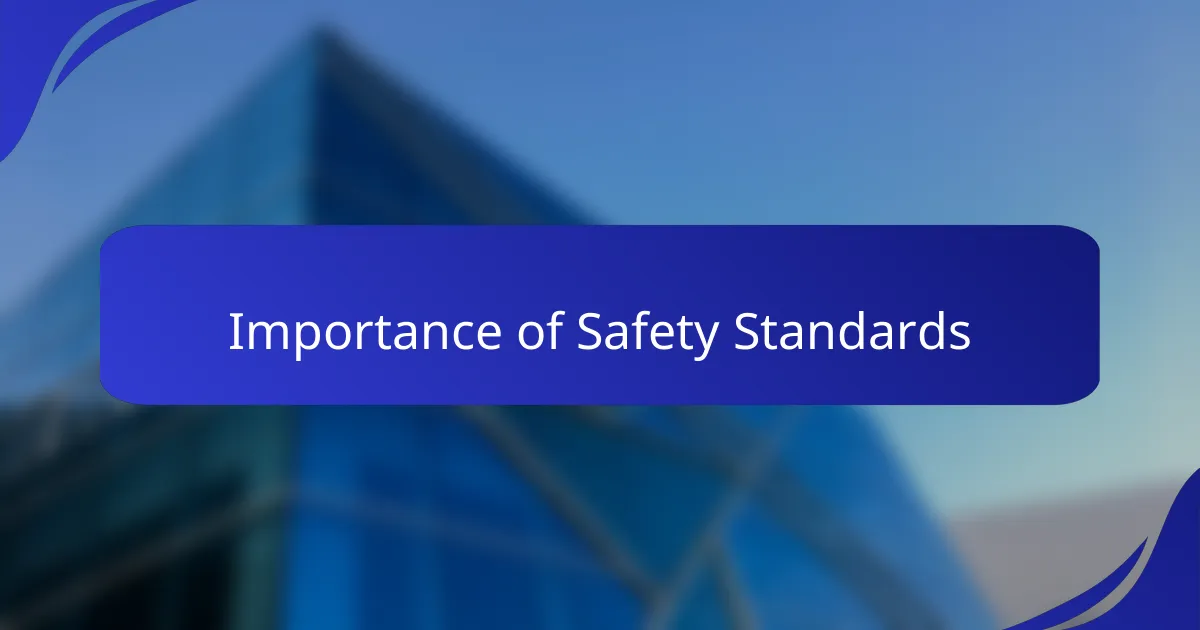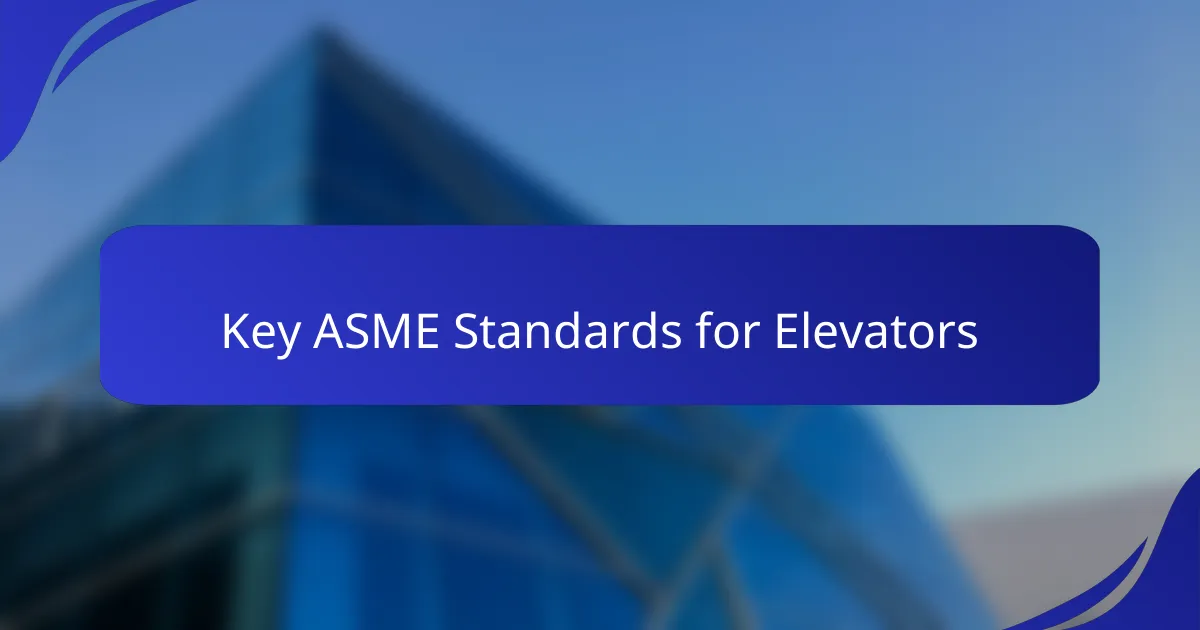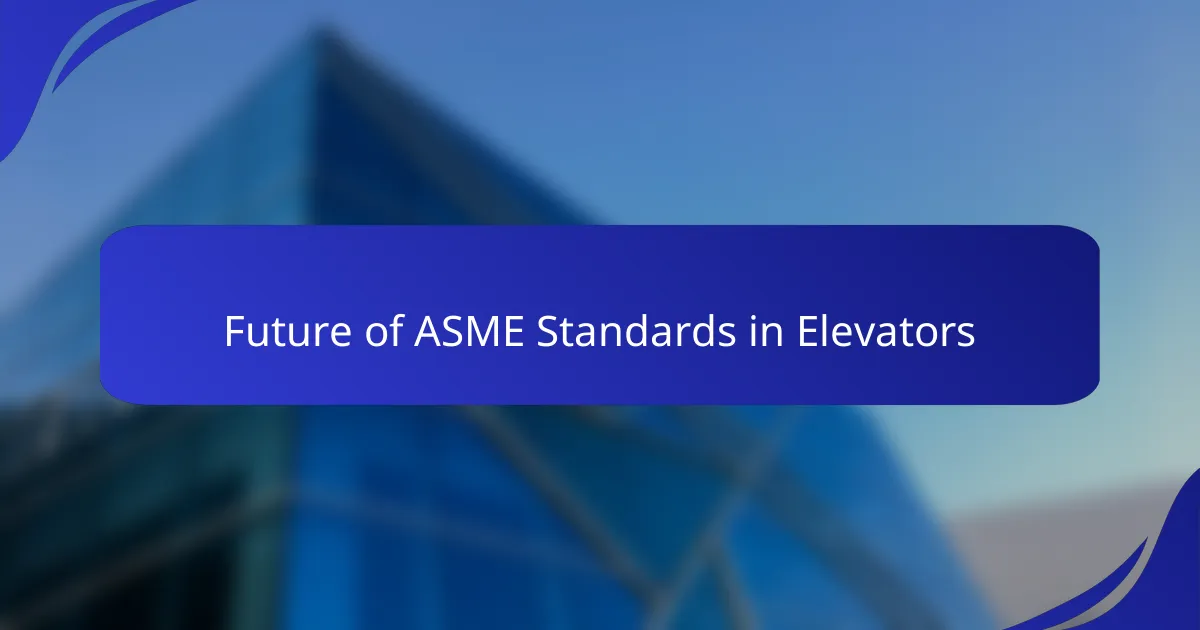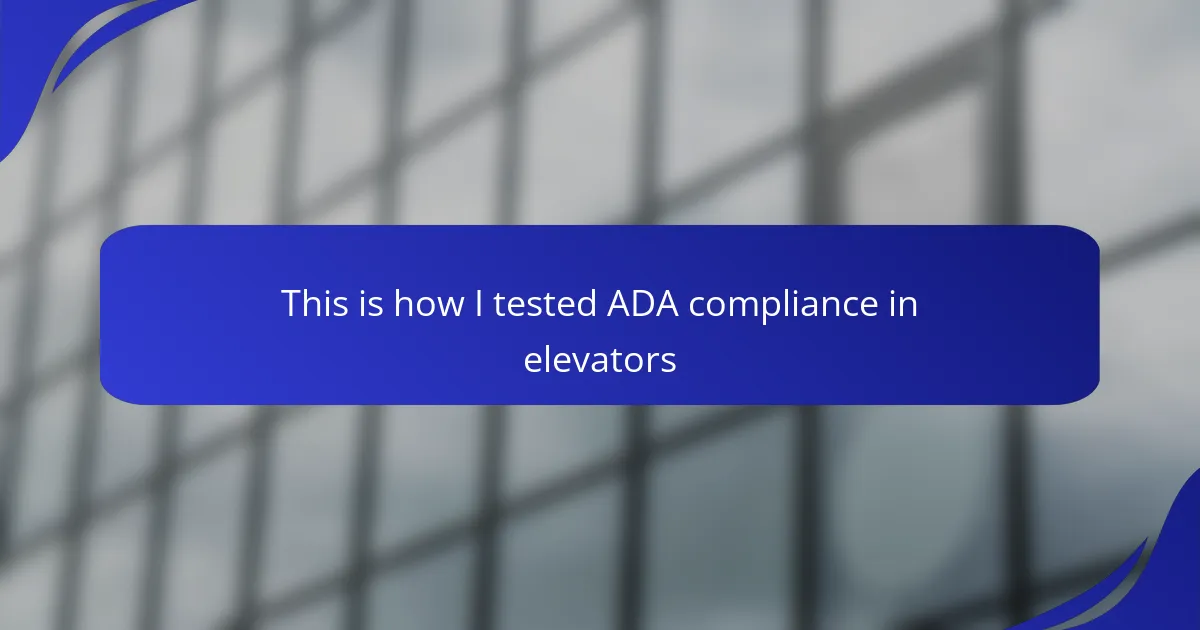Key takeaways
- ASME A17.1 is a cornerstone standard ensuring safety and reliability in elevator design and operation.
- The elevator industry has evolved from simple pulley systems to smart technologies, enhancing performance and sustainability.
- Challenges in implementing ASME standards include keeping up with technological advancements and ensuring proper training for personnel.
- The future of ASME standards will focus on integrating new technologies and addressing cybersecurity concerns in smart elevators.

Overview of ASME Standards in Elevators
When I first delved into ASME standards, I was surprised by their foundational role in the elevator industry. The American Society of Mechanical Engineers (ASME) has established guidelines that ensure safety, reliability, and efficiency in elevator design and operation. These standards aren’t just bureaucratic red tape; they are a safety net for users and a benchmark for engineers.
One of the key standards is ASME A17.1, which outlines safety codes for elevators and escalators. I remember reading through these regulations and considering how they help prevent accidents that could endanger lives. Isn’t it reassuring to know that these standards are in place to protect not only the maintenance workers but also everyday passengers?
In my experience, ASME standards also spur innovation. By providing a clear framework, they encourage engineers to push the boundaries while adhering to safety. Have you ever thought about how much trust we place in these machines? It’s often easy to overlook the rigorous testing and standardization behind the scenes that make our daily commutes safe and efficient.

Evolution of the Elevator Industry
Elevators have come a long way since their inception in ancient times, where simple pulley systems facilitated vertical movement. In the early 19th century, the introduction of steam-powered elevators revolutionized the construction industry, allowing buildings to reach unprecedented heights. I often think about how the skyline of cities would look so different if not for those early innovations.
As technologies advanced, so did the complexity of elevators. The integration of electrical systems in the late 1800s not only improved efficiency but also resolved many safety concerns that plagued earlier designs. Reflecting on this evolution, I can’t help but marvel at how each advancement has shaped our urban environments, making high-rise living a practical reality for many.
Today, the elevator industry continues to evolve with the advent of smart technology. Modern elevators are equipped with sophisticated control systems that enhance performance and user experience. It’s fascinating to see how these developments not only increase efficiency but also align with the push for sustainability, showcasing how far we’ve come in prioritizing both functionality and environmental responsibility.

Importance of Safety Standards
When I think about the importance of safety standards in the elevator industry, I can’t help but reflect on my early experiences. I vividly remember the first time I rode in an elevator that was certified to ASME standards. It gave me a sense of security, knowing that rigorous tests and regulations were in place to ensure my safety. This personal connection emphasizes how vital these standards are, not just for compliance but for fostering public trust in the technologies we use daily.
Safety standards like those established by ASME ensure that elevators are not only operational but also stable and reliable. They encompass everything from design to installation and maintenance, ensuring that every aspect of an elevator’s life cycle is scrutinized for safety. When I analyze these standards, I see a blueprint that prioritizes human wellbeing over mere efficiency.
Here’s a comparison of the approaches taken by ASME standards versus industry practices without standards:
| Aspect | ASME Standards | Industry Practices (Without Standards) |
|---|---|---|
| Safety Testing | Rigorous and regular assessments | Varied testing, if any |
| Regulatory Oversight | Followed by certified inspectors | Minimal or no oversight |
| User Confidence | High, due to enforced regulations | Lower, due to lack of uniformity |

Key ASME Standards for Elevators
ASME A17.1 is certainly a cornerstone standard in the elevator industry, and I find it fascinating how its guidelines shape our safety net. It covers everything from installation to inspection, ensuring each elevator can be trusted to operate smoothly. Whenever I step into an elevator, I can’t help but feel a wave of comfort knowing that these comprehensive regulations are in play, consistently working to protect me.
Another pivotal standard is ASME A17.3, which focuses on the maintenance and repair of existing installations. I’ve often pondered how crucial it is for maintenance crews to have clear directives for their work. This standard not only preserves the integrity of elevators but also translates to peace of mind for users. It makes you wonder—how often do we think about the professionals behind the scenes ensuring our safety?
On a more technical note, ASME B20.1 addresses the safety of conveyances in general, including elevators, escalators, and lifts. There’s something reassuring about knowing that specific design and operational requirements are in place for all these devices. It reminds me that the engineering behind elevators isn’t just about function; it’s about creating a symbiotic relationship between technology and human experience, enhancing our journeys in everyday life.

Personal Insights on ASME Analysis
When I began my analysis of ASME standards within the elevator industry, I was struck by how foundational these guidelines are to safety and innovation. I recall visiting a manufacturing plant where I saw firsthand how adherence to these standards not only protected workers but also instilled a sense of pride in producing high-quality elevators. It felt rewarding to understand that these standards serve as a backbone for the industry, ensuring that each elevator is built reliably and efficiently.
As I dove deeper, I discovered that ASME standards aren’t just regulatory checkboxes. They represent the collective knowledge and experience of countless professionals over the decades. My conversations with industry veterans revealed their stories of how these standards evolved to meet new challenges, reflecting a commitment to continuous improvement in safety and performance.
| Aspect | Description |
|---|---|
| Safety Regulations | ASME standards prioritize passenger safety and specify rigorous testing parameters for elevators. |
| Innovation Driver | They encourage manufacturers to adopt new technologies while ensuring compliance with safety norms. |
| Industry Trust | Compliance builds trust among consumers, reassuring them of quality and reliability. |

Challenges in Implementing ASME Standards
Implementing ASME standards in the elevator industry presents unique challenges that I’ve observed firsthand throughout my career. One significant hurdle is the constant evolution of technology, which demands that standards be updated regularly to remain relevant. I’ve seen companies struggle to balance compliance with the need for innovation, often leading to frustration among engineers and stakeholders.
Another challenge lies in the training and education of personnel. Many employees may not fully understand the technical nuances of ASME standards, which can lead to mistakes or oversights in installation and maintenance. I recall a project I was involved in where inadequate training resulted in costly delays, highlighting the importance of a comprehensive understanding of these standards to ensure safety and reliability in elevator operations.
| Challenge | Description |
|---|---|
| Technological Evolution | Standards must be frequently updated to match the pace of innovation in elevator technologies. |
| Training and Education | Personnel often lack sufficient knowledge of ASME standards, leading to potential errors in implementation. |

Future of ASME Standards in Elevators
The future of ASME standards in the elevator industry looks both promising and challenging, reflecting the rapidly changing landscape of technology. As I think about emerging innovations—like smart elevators using artificial intelligence—I realize these advancements necessitate constant updates to the standards. It’s a fascinating balancing act: how do we maintain safety while embracing cutting-edge technology?
I can’t help but feel enthusiastic about the prospect of ASME standards evolving to incorporate newer materials and technologies. For example, when I learned about the potential use of lighter, yet stronger materials, it prompted me to consider the implications for safety and design. Will these materials change the way we think about weight limits and structural integrity? That question emphasizes the need for adaptive standards that can keep pace with innovation in the industry.
Moreover, I believe that as the industry becomes more interconnected through IoT (Internet of Things), ASME standards will need to address not only safety but also cybersecurity concerns. Reflecting on how we’ve begun to rely heavily on technology, I often find myself pondering: how do we ensure our safety without compromising our digital security? The answers to these questions will shape the evolving framework of ASME standards, ultimately guiding us toward a safer and more advanced future in elevator technology.



